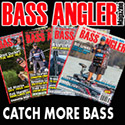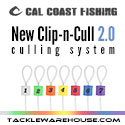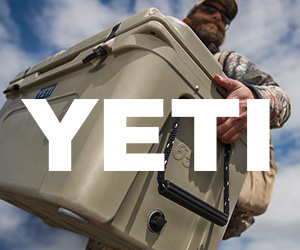River2Sea's
Dahlberg Diver Frog Kicks Bass (continued)

 Real World Tests:
To test the Larry Dahlberg Diver Frog I headed to my favorite two bodies of
water for frog fishing, Clear Lake and the tule lined California Delta. I fished
the frog for a season and tried it on both warm sunny days as well in cooler
foul weather. I also fished the frog on a variety of rods and employed both
braided and monofilament lines.
Real World Tests:
To test the Larry Dahlberg Diver Frog I headed to my favorite two bodies of
water for frog fishing, Clear Lake and the tule lined California Delta. I fished
the frog for a season and tried it on both warm sunny days as well in cooler
foul weather. I also fished the frog on a variety of rods and employed both
braided and monofilament lines.

...this odd
looking weedguard is the lure's diving collar
Casting:
The LDDF weighs more than most frogs at 1oz. and casts like a bullet. The lure
is weighted towards the back and casts very easily both long and short
distances. It is also easy to flip and pitch into pockets. The one area that the
frog doesn't cast as well is when skipping under docks and pilings. The legs and
diving collar create additional resistance and the frog dies quickly after it
makes contact with the water, unlike Snag Proof style frogs which can skirt into
tight areas with the right casting trajectory and power.

The diving
collar extends below the flat belly
Retrieve:
The LDDF may not be the most realistic looking frog out of the water but in the
water the lure is able to generate a very realistic swimming motion. The legs on
the frog rest in a natural upright position alongside the body when still, but
when the LDDF is retrieved the resistance in the water causes the legs to extend
straight backwards creating the illusion that the frog’s legs are actually
propelling the lure forward. The LDDF exhibits some of the most natural looking
swimming action and can be fished both fast and slow. When fished slow and
paused the lure will splash water and create a bubble trail wake, the harder you
pull the more the lure will dive and at total rest the frog will float up to the
surface.

Out of the
water the soft legs extend
With a steady retrieve the
LDDF dives under the surface but doesn’t get very far down, but by stopping and
jerking the frog the diving lip is able to dig in and get the frog to gain depth
with each consecutive pull. It is possible to get the frog a few feet under the
surface by repeating this process but I caught more fish when it was on the
surface versus deep. The LDDF is most effective on top of the water
and fish strike it both when it is moving or at total rest between pauses on the
surface.

At rest in the
water the legs curl upwards
If you like walking frogs
this is probably not the bait for you as it requires a completely different type
of action imparted on the rod, but most beginner frog fishermen will probably
find it easier to fish than learning that perfect cadence necessary to walk
traditional hollow bellied frogs. Like with other frogs braided line helps make
it easier to drive the hook into fish the split second they strike and also
makes it easier to muscle them out of the slop.

The splash the
second the LDDF is retrieved
The LDDF’s diving collar also
is the lure’s weedguard and prevents the bait from hanging up on vegetation. The
collar’s plastic extends upwards like a wire guard on a jig and we found that
design did prevent the lure from hanging up on both weedy and mossy types of
vegetation. The diving collar does add some resistance to the bottom of the lure
and it does not skip across some really sticky vegetation as well as
conventional flat bellied frogs. Nonetheless the design does do a surprisingly
good job and hookups on this frog were actually better than most frogs where the
fish really has to compress the soft body of the lure to properly expose the hooks.

Notice the
legs also extend backwards giving the illusion the frog is propelling itself
when retrieved

























